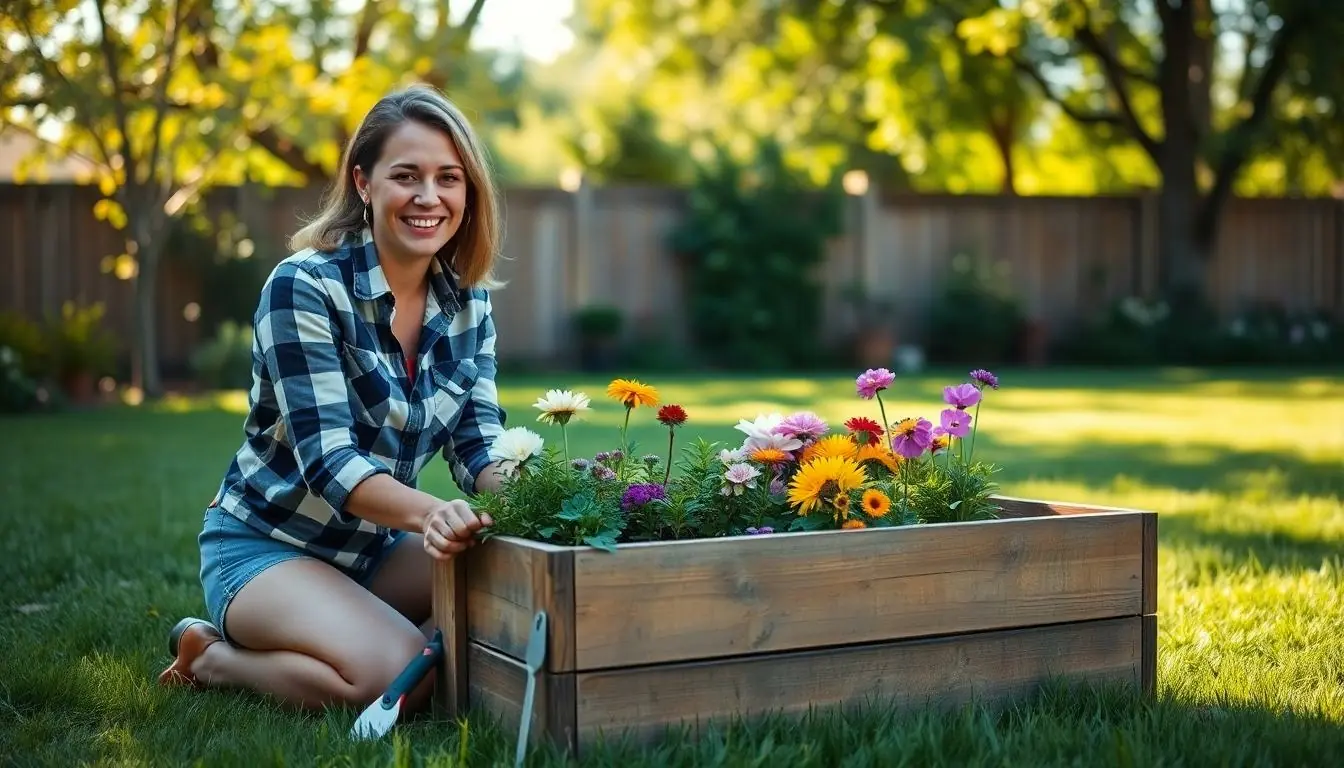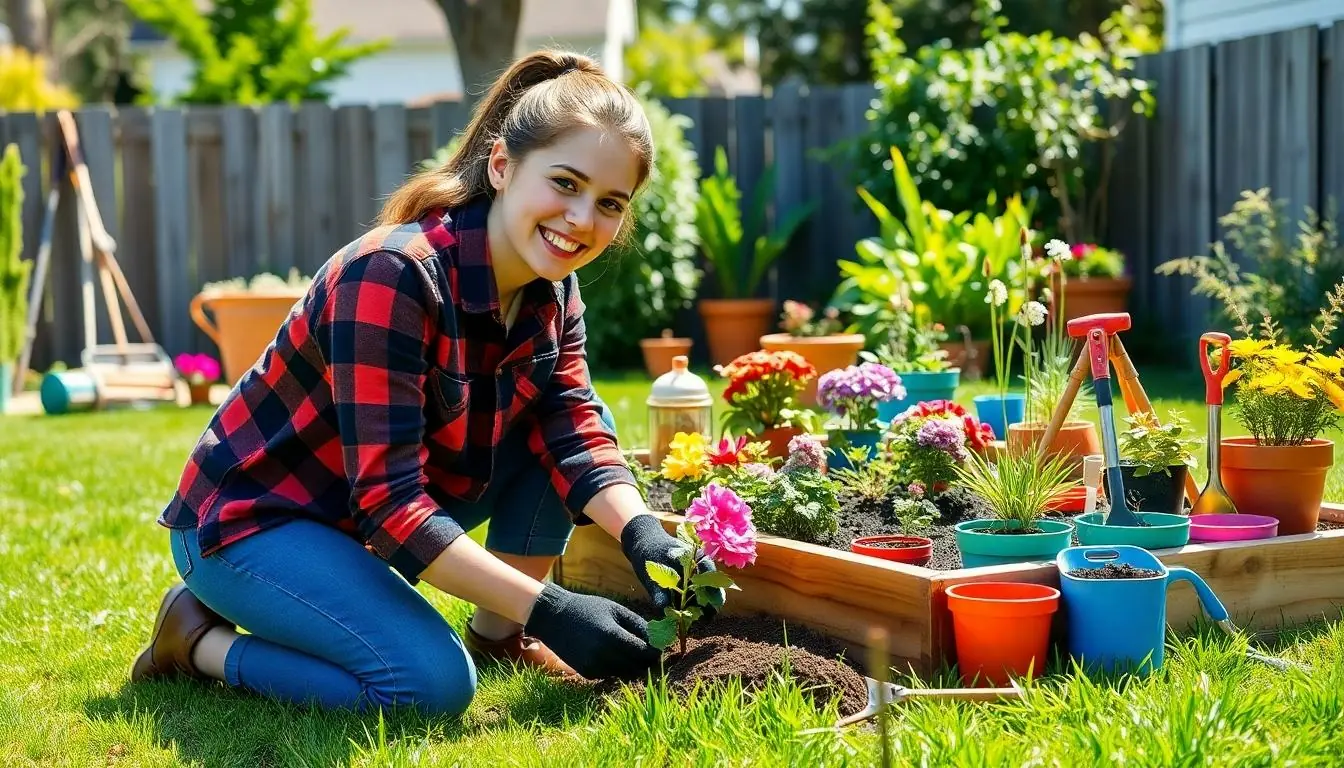Table of Contents
ToggleWhen the great outdoors calls, it’s time to answer with a hammer in one hand and a paintbrush in the other. DIY outdoor projects not only elevate the charm of any backyard but also unleash creativity that’s been trapped inside four walls. Whether it’s crafting a cozy fire pit or building a whimsical birdhouse, these projects promise to transform dull spaces into personal paradises.
Popular DIY Outdoor Projects
Exploring popular DIY outdoor projects adds beauty and charm to any backyard. These projects not only enhance outdoor spaces but also offer a personal touch.
Garden Planters
Creating garden planters transforms ordinary areas into vibrant displays. Individuals can use wooden pallets or reclaimed materials to make unique planters. Utilizing varied sizes and shapes adds character to gardens. Plants thrive in elevated planters, providing better drainage and accessibility. Choose plants based on sunlight and climate to ensure successful growth. Decorative elements, like paint or stenciling, personalize each planter, showcasing creativity.
Outdoor Furniture
Building outdoor furniture offers functionality along with style. A simple picnic table or bench enhances outdoor socializing. Using pressure-treated lumber guarantees durability against weather elements. Choosing designs that fit specific needs, like an outdoor sofa or coffee table, adds cozy seating. Staining or sealing wood ensures longevity, protecting it from moisture and sun. DIY cushions can complement furniture, providing comfort and color to outdoor spaces.
Tools and Materials Needed

Gathering the right tools and materials makes DIY outdoor projects efficient and enjoyable. Familiarizing oneself with essential items lays the foundation for successful project completion.
Essential Tools
A sturdy tape measure ensures accurate measurements. A handsaw or circular saw provides precision cuts for various materials. Strong power drills drive screws and create holes easily. Clamps secure pieces together during assembly. Safety goggles protect eyes from debris. A level makes sure surfaces are even and straight. Portable work tables offer a stable work surface, benefiting many projects.
Recommended Materials
Pressure-treated lumber withstands the elements for durability. Composite materials resist rot and insect damage, ideal for outdoor furniture. Quality outdoor paint or wood stain enhances appearance and protects surfaces. Screws and nails should be weather-resistant to ensure longevity. Landscape fabric prevents weed growth in garden beds. Gravel or mulch promotes drainage around plants. Local stone can create borders and pathways, adding natural beauty to outdoor spaces.
Step-by-Step Guides
These guides provide clear instructions for popular DIY outdoor projects. Following these steps ensures a successful and enjoyable experience.
Building a Raised Garden Bed
Start by selecting a suitable location with plenty of sunlight. Measure and mark the dimensions for the raised bed, typically 4 feet by 8 feet. Gather pressure-treated lumber for durability and cut the wood to size. Assemble the frame using weather-resistant screws, ensuring it’s level. Line the bottom with landscape fabric to prevent weeds. Fill the bed with a mix of quality soil and compost to promote healthy plant growth. Finally, select plants according to local climate and garden design preferences. Water consistently to keep plants thriving.
Creating a Fire Pit
Decide on the fire pit’s location, ensuring it’s a safe distance from structures and trees. Mark a circular area, typically 3 to 4 feet in diameter, using stones or spray paint. Dig the area to a depth of about 6 inches. Line the bottom with gravel for drainage before adding a ring of concrete blocks or stones. Ensure the construction is stable and aesthetically pleasing. Use fire pit-specific materials if desired. Surround the fire pit with seating, aiming for comfort during gatherings. Always prioritize safety by keeping a water source nearby and checking local regulations.
Tips for Successful DIY Projects
Successful DIY outdoor projects require careful planning and implementation. Understanding key elements ensures smooth execution and satisfying results.
Planning and Design
Start by visualizing the end result. Sketching designs allows clarity. Consider factors like space, purpose, and aesthetics. Research materials that suit the project needs. Gathering inspiration from websites or community forums fuels creativity. Create a list of necessary tools and materials, allowing efficient shopping. Measure the workspace accurately, ensuring everything fits well. Allocate time realistically, accommodating potential challenges. Set clear objectives to guide the entire process. Planning elevates the overall quality and enjoyment of outdoor projects.
Safety Precautions
Safety forms the foundation of any DIY project. Wearing appropriate safety gear prevents accidents. Goggles protect eyes from dust and debris. Gloves provide hand protection against sharp tools or rough materials. Using sturdy, well-maintained tools minimizes risks significantly. Speaking of tools, understanding their proper use enhances safety and efficiency. Always secure workpieces to avoid movement during cutting or drilling. Following local regulations regarding outdoor projects ensures compliance. Keeping a first-aid kit nearby supports prompt action in case of injuries. Prioritizing safety creates a secure environment for creativity and expression.
DIY outdoor projects offer a unique opportunity to transform spaces while showcasing individual creativity. By engaging in these projects, individuals can create beautiful and functional areas that enhance their outdoor experience. Whether it’s building a cozy fire pit or crafting personalized garden planters, the possibilities are endless.
With the right tools and materials, anyone can embark on these rewarding projects. Prioritizing safety and proper planning ensures a smooth process from start to finish. Ultimately, these DIY endeavors not only beautify outdoor spaces but also foster a sense of accomplishment and connection to nature. Embracing the DIY spirit can lead to stunning results that reflect personal style and enhance the enjoyment of outdoor living.







